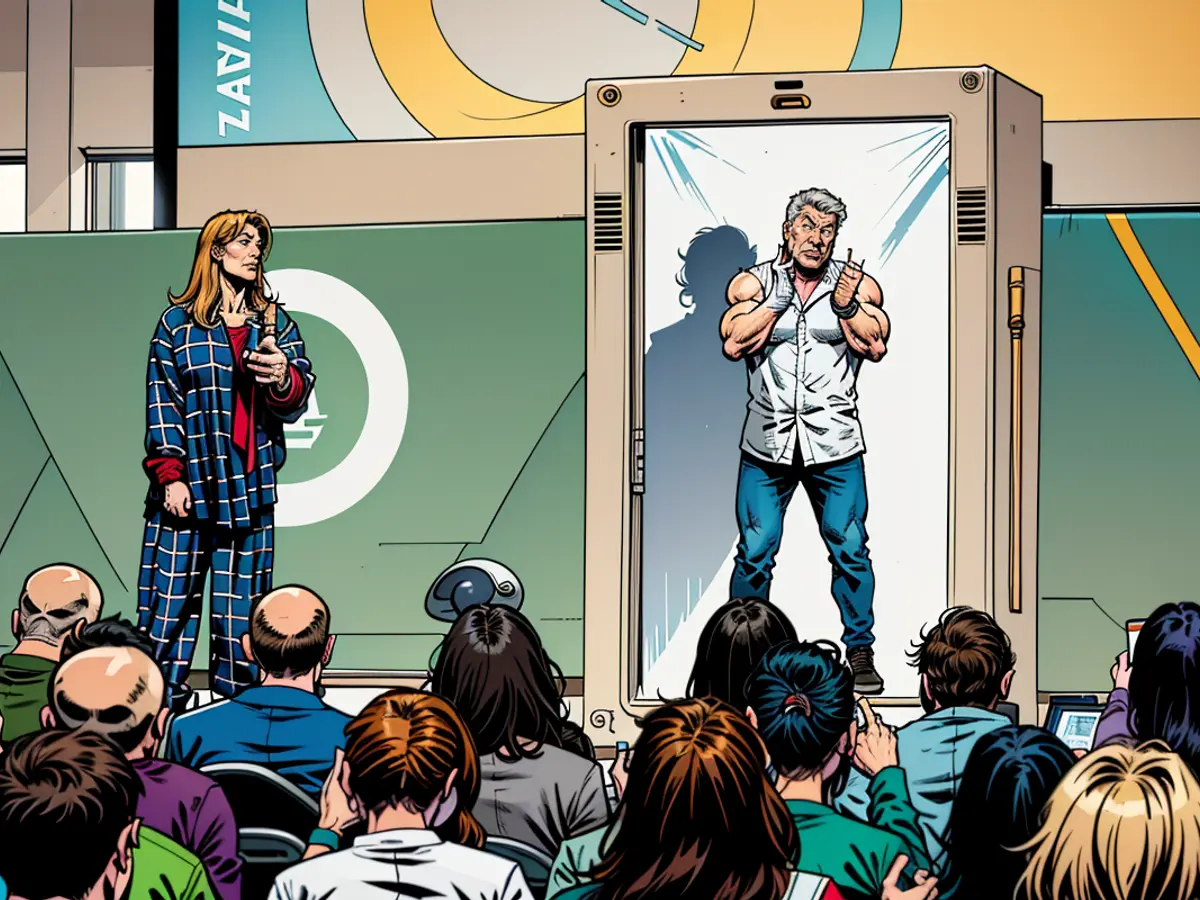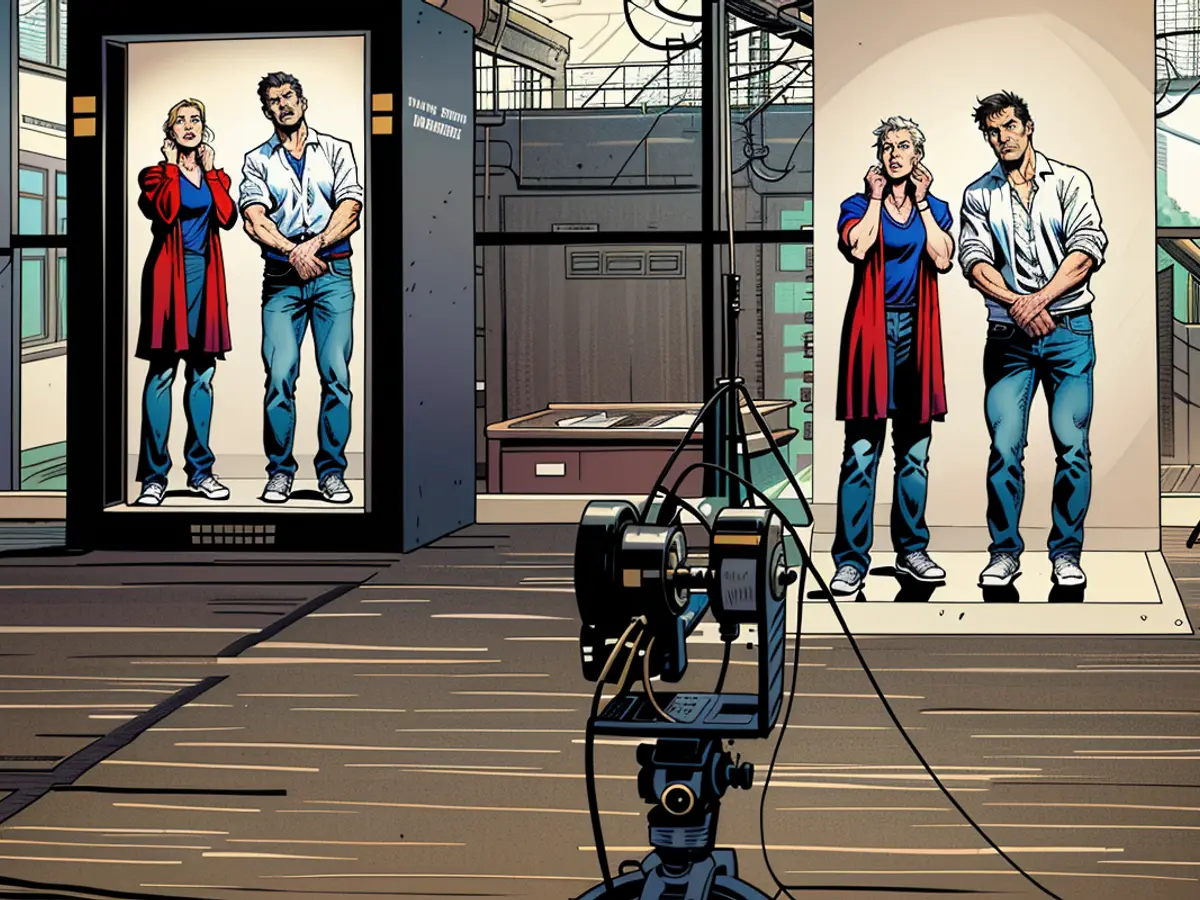3D Video Projectors Transmit Holographic Images Directly into Your Lounge Area
The company has manufactured a hefty device that surpasses the height of an average NBA player and weighs over 400 pounds. This invention has the capability to exhibit a video of an individual, giving the impression of three-dimensionality through clever visual tricks and graphical manipulations.
This device can reproduce saved videos as well as live feeds, and any high-definition camera, such as an iPhone, can serve as the source. Although the images aren't technically holograms, the addition of shadows behind the figure and reflections underneath the feet mislead the brain into assuming there's a person inside it.
David Nussbaum, the founder and CEO of the company, shared an example of its utilization, stating, "We teleported William Shatner from Los Angeles to Orlando, Florida, to attend an event he couldn't physically attend in person."
Nussbaum established Proto in 2018 and has a team of 45 employees. The company has sold close to 1,000 units.
There are two full-sized versions of this device; the Proto Epic and the Proto Luma, which sell for $29,000 to $65,000 respectively. The Proto M, a tabletop version, is 30 inches tall, weighs just under 30 pounds and is priced at $5,900.
Although it's considerably more expensive than a standard video call, the company does offer a leasing option for their full-size model at $2,500 per month.
A single Proto device is sufficient to establish a connection, but Proto-to-Proto communication is currently unsupported; however, two Proto users can communicate with each other using a secondary camera, such as a smartphone.
Nussbaum describes Proto as a "business-to-business company," with high-profile clients like Amazon (AMZN), Verizon (VZ), Siemens, Accenture, Walmart (WMT), the NFL, and major US TV networks. However, he foresees a future where its smallest device might be accessible for less than $1,000 for home use.
By placing a 2D image in a life-size 3D space, Proto creates a more captivating experience than a standard video call. "You see me as if I'm right there. This makes our conversation more genuine, more engaging," Nussbaum explained.
Proto boxes have been deployed at New York's JFK airport and the Beverly Wilshire hotel in Beverly Hills, offering concierge service in suites and penthouses.
A similar technology launched by Dutch company Holoconnects has been used in Scandinavian hotels and for advertising by BMW. Google is collaborating with HP to commercialize Project Starline, promising to enhance video conferencing conversations with more depth and realism, and Cisco is working on integrating holograms into Webex.
Recently, Proto has started collaborating with universities, including Central Florida, MIT, Vanderbilt, Stanford, and the University of Loughborough in the UK, to beam in guest lecturers from around the world.
Gary Burnett, a professor of digital creativity at Loughborough University, who has used the Proto boxes, said, "In our initial trial lectures, it was evident that students felt a strong sense of co-presence with the hologram speaker, believing them to be 'in the room,' sentient, and behaving like an authentic lecturer."
"Most students paid attention throughout the session, and although this wasn't a formal part of their education, it was apparent that they were learning, as evidenced by a surprise quiz at the end of the lectures," Burnett added.
Immersive Experience
Earlier this year, Proto began a partnership with West Cancer Center, allowing doctors in remote areas to 'beam' into clinics.
"For oncology and palliative care patients, non-verbal communication is critically important because we often communicate complex information and sometimes deliver difficult or challenging news," said W. Clay Jackson, a doctor at the clinic and a professor at the University of Tennessee.
"The patient experience with Proto is vastly superior to traditional, screen-based tele-health formats. The life-size, three-dimensional image truly immerses the patient in the visit, allowing them to communicate effectively, almost as if you could touch them," Jackson said.
One of Jackson's patients, Crystal Freeman, praised the technology for serving rural patients better than standard virtual visits. "I've had tele-health visits, but the service can be spotty, and you don't have the feeling of being in an actual doctor visit," Freeman said.
Nussbaum employs the technology at home to connect his children in Los Angeles with his parents in New Jersey, a scenario where a video call doesn't quite meet the mark.
"Of course, you can communicate, but you can't connect. So I thought, what if I could beam them into each other's house? Now we're doing that. This, to me, is a glimpse into the future as I watch my parents and my kids interact from 3,000 miles away. That, to me, is one of the greatest things we're doing," Nussbaum said.
The tech industry is showing a growing interest in 3D telepresence technology, with companies like Google collaborating with HP on Project Starline and Cisco integrating holograms into Webex. In the business world, Proto has established partnerships with high-profile clients such as Amazon (AMZN), Verizon (VZ), and Siemens, among others.
David Nussbaum, the CEO of Proto, sees a future where the smaller Proto devices might be accessible for less than $1,000 for home use, making this tech more affordable and widespread in the business and personal sectors.









